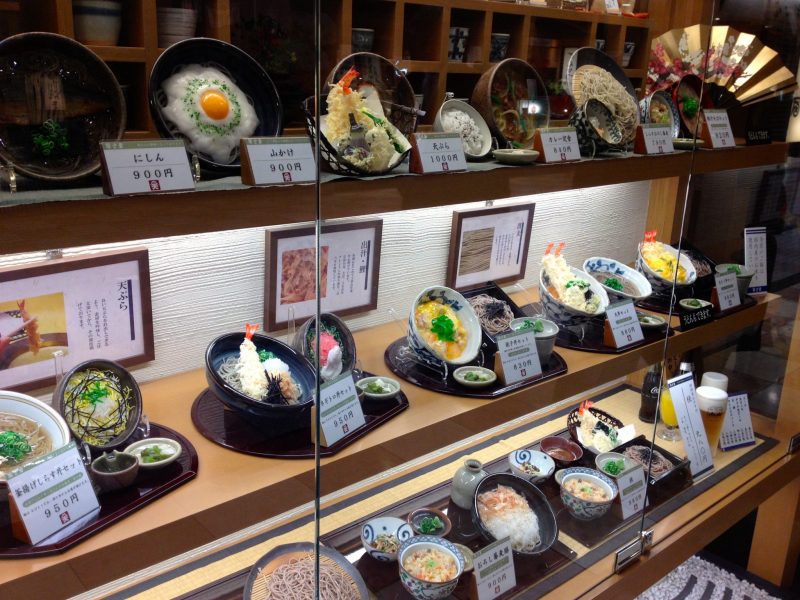1. Location, Location, Location
If you’re thinking you can go to a restaurant in the Ginza or the Gion and find an inexpensive meal, think again. It is simple economics. It is said the real estate in the Ginza is the most expensive in the world. This expense will get passed on in the prices. These type of restaurants are either for special occasions, or for businessmen on corporate expense accounts trying to impress clients. If you want to save some money, go to the “lower rent districts” such as Asakusa, Ueno or Shibuya in Tokyo, or just about anywhere in Osaka. And, if you want to splurge, do it somplace like Osaka or other less expensive places.
2. Go underground
All over Japan you will find underground shopping arcades, especially near train stations. Some of the largest complexes can be found in Osaka. (It is so large, I still get lost going there sometimes after going there many, many times.) . Many of the shops in these underground arcades will normally be restaurants. Since there is a high concentration of restaurants at these places, the competition to attract customers is high. So the restaurants will have to keep their prices low in order to be competitive.
3. Go to the train stations
This is like telling an American to go to the airport to save money on dining out. But in Japan, many reasonably priced rstaurants are found in and around train stations. People are on the move when they go to the train station, and they just want something quick, easy and inexpensive. At the larger train stations, on the platforms you can find noodle shops. You will have to purchase your ticket from the vending machine outside the entrance, hand your ticket to the staff and stand as you eat (there are no tables). It is also an intersting cultural experience eating shoulder-to-shoulder with Japanese “salarymen”.
4. Make lunch your main meal
Many Japanese restaurants will have lunch set meals that are very good deals, and include unlimited refills of miso soup and rice. And many restaurants will raise their prices at dinner, making the lunch set meals an even better deal.
5. Specialty restaurants
It is not hard to find specialty restaurants in Japan. As a matter of fact, restaurants with a varied menu are the exception. Because the specialty restaurants focus on one thing, they are able to create the meals more economically, and usually better. Good examples of these are noodle shops, curry restaurants, tempura restaurants and kaitenzushi restaurants.
6. Mom and Pop Restaurants
Everywhere you go in Japan, you will find tiny restaurants with just a few tables. And usually the owners live above the restaurant. This arrangement creates a low overhead, allowing the restaurant to offer thier meals at a lower cost. They may not always speak a lot of English, but they will always do their best to make you feel at home and help you.
7. Grocery Stores/Convenience Stores
I would never consider purchasing prepared food from a convenience store in America. However, if you are in a hurry, convenience stores can be a quick, easy and inexpensive option in Japan. Almost all grocery stores will offer prepared foods. And since they will have to throw the food out if it doesn’t sell, if you got to the store later in the day, they will begin to discount those items that haven’t sold. Both grocery stores and convenience stores will provide chopsticks, so if you go to either a convenience store or grocery store, you can find a spot for a picnic lunch and for some people watching. And I always say that grocery stores are one of the best places to learn more about a culture.
8. Kissaten (Coffee and tea shop or cafe)
If you go to to a Japanese chain tea/coffee shop, you can get a sandwich and a coffee or tea at Veloce Coffee for less than the cost of a coffee at the larger American coffee shop chain stores. Or, at the Mermaid Cafe, you can get a set meal of a sandwich, salad, vegetable and pastry desert for about the cost of a bowl of noodles.
9. Japanese Fast Food
There are a number of Japanese “fast food” chains found everywhere in Japan. These include shops like Yoshinoya, famous for its beef and rice bowls. Or Nakau, serving noodles and curry and rice. Or Sukiya serving donburi (rice bowls) and curry and rice. While these will certainly not win any culinary awards or earn Michelin stars, they do serve simple and basic food at a very reasonable price.
10. Set Meals
In Japanese, they are called “teishoku”, or simply “setto”. Usually, for just another 100 Yen or so, you can add rice, soup and pickles to your meal. Most Japanese reataurants will have this option available, and it is certainly worth asking for.





